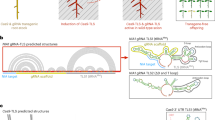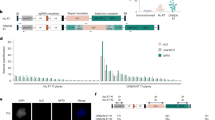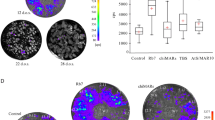Abstract
We describe a new plant transformation vector system which utilizes the transposition functions of the maize Ac/Ds transposable element family to re-position transgenes in transgenic crop plants. The practical applications of the system are two-fold. It allows the production of plants which exhibit a range of different stabilizable transgene expression levels following a single primary transformation event, and it allows for the elimination of specific transgene sequences—such as a selectable marker gene—subsequent to the transformation event. We have demonstrated the system using the NptII selectable marker gene and a Ds element containing the GUS reporter gene. Progeny plants were recovered from primary transformants from which either the NptII gene or the Ds/GUS element have been eliminated. We also show that the expression level of the GUS gene within both individual and amplified Ds elements can vary as a function of their position in the genome following transposition.
This is a preview of subscription content, access via your institution
Access options
Subscribe to this journal
Receive 12 print issues and online access
$209.00 per year
only $17.42 per issue
Buy this article
- Purchase on Springer Link
- Instant access to full article PDF
Prices may be subject to local taxes which are calculated during checkout
Similar content being viewed by others
References
Dean, C., Jones, J., Favreau, M., Dunsmuir, P. and Bedbrook, J. 1988. Influence of flanking sequences on variability in expression levels of an introduced gene in transgenic tobacco plants. Nucl. Acids Res. 16: 9267–9283.
Bryant, J. and Leather, S. 1992. removal of selectable marker genes from transgenic plants: needless sophistication or social necessity? TIBTECH 10: 274–275.
Nap, J-P., Bijvoet, J. and Stiekema, W.J. 1992. Biosafety of kanamycin-resistant transgenic plants. Transgenic Research 1: 239–249.
Flavell, R.B., Dart, E., Fuchs, R.L. and Fraley, R.T. 1992. Selectable marker genes: Safe for plants? Bio/Technology 10: 141–144.
Gressel, J. 1992. Indiscriminate use of selectable markers—sowing wild oats? TIBTECH 10: 382.
Dale, P.J. 1992. Spread of engineered genes to wild relatives. Plant Physiol. 100: 13–15.
Russell, S.H., Hoopes, J.L. and Odell, J.T. 1992. Directed excision of a transgene from the plant genome. Mol. Gen. Genet. 234: 49–59.
Dale, E.C. and Ow, D.W. 1991. Gene transfer with subsequent removal of the selection gene from the host genome. Proc. Nat. Acad. Sci. USA 88: 10558–10562.
McKnight, T.D., Lillis, M.T. and Simpson, R.B. 1987. Segregation of genes transferred to one plant cell from two separate Agrobacterium strains. Plant Mol. Biol. 8: 439–445.
McClintock, B. 1948. Mutable loci in maize. Carnegie Inst. of Wash. Year Book 47: 155–169.
Fedoroff, N., Wessler, S. and Shure, M. 1983. Isolation of the transposable maize controlling elements Ac and Ds. Cell 35: 235–242.
Balcells, L., Swinburne, J. and Coupland, G. 1991. Transposons as tools for the isolation of plant genes. TIBTECH 9: 31–37.
Lassner, M.W., Palys, J. and Yoder, J.I. 1989. Genetic transactivation of Dissociation elements in transgenic tomato plants. Mol. Gen. Genet. 218: 25–32.
Scofield, S.R., Harrison, K., Nurrish, S.J. and Jones, J.D.G. 1992. Promoter fusions to the Activator transposase gene cause distinct patterns of Dissociation excision in tobacco cotyledons. Plant Cell 4: 573–582.
Swinburne, J., Balcells, L., Scofield, S.R., Jones, J.D.G. and Coupland, G. 1992. Elevated levels of Activator transposase mRNA are associated with high frequencies of Dissociation Excision in Arabidopsis. Plant Cell 4: 583–595.
Masterson, R.V., Furtek, D.B., Grevelding, C. and Schell, J. 1989. A maize Ds transposable element containing a didydrofolate reductase gene transposes in Nicotiana tabacum and Arabidopsis thaliana. Mol. Gen. Genet. 219: 461–466.
Dooner, H.K., Keller, J., Harper, E. and Ralston, E. 1991. Variable patterns of transposition of the maize element Activator in tobacco. Plant Cell 3: 473–482.
Greenblatt, I. 1984. A chromosome replication pattern deduced from pericarp phenotypes resulting from movements of the transposable element Modulator in maize. Genetics 108: 471–485.
Jones, J.D.G., Carland, F., Lim, E., Ralston, E. and Dooner, H.K. 1990. Preferential transposition of the maize element Activator to linked chromosomal locations in tobacco. Plant Cell 2: 701–707.
Belzile, F., Lassner, M.W., Tong, Y., Khush, R. and Yoder, J.I. 1989. Sexual transmission of transposed Activator elements in transgenic tomatoes. Genetics 123: 181–189.
Goldsbrough, A. and Bevan, M. 1991. New patterns of gene activity in plants detected using an Agrobacterium vector. Plant Mol. Biol. 16: 263–269.
Yoder, J.I. 1990. Rapid proliferation of the maize transposable element Activator in transgenic tomato. Plant Cell 2: 723–730.
Marion-Poll, A., Marin, E., Bonnefoy, N. and Pautot, V., 1993. Tranposition of the maize autonomous element Activator in transgenic Nicotiana plumbaginifolia plants. Mol. Gen. Genet. 238: 209–217.
Hardeman, K.J. and Chandler, V.L. 1989. Characterization of bzl mutants isolated from mutator stocks with high and low numbers of Mul elements. Developmental Genet. 10: 460–472.
Topping, J.F., Wei, W. and Lindsay, K. 1991. Functional tagging of regulatory elements in the plant genome. Development 112: 1009–1019.
Bevan, M.W. 1984. Agrobacterium vectors for plant transformation. Nucl. Acid Res. 12: 8711–8721.
Thomas, C.M., Meyer, R. and Helinski, D.R. 1980. Regions of broad-host-range plasmid RK2 which are essential for replication and maintenance. J. Bacteriol. 141: 213–222.
Hirsch, P.R., Wang, C.L. and Woodland, M.J. 1986. Construction of a Tn5 derivative determining resistance to gentamycin and spectinomycin using a fragment cloned from R1033. Gene 48: 203–209.
Peralta, E.G., Hellmiss, R. and Dean, W. 1986. Overdrive, a T-DNA transmission enhancer on the A. tumefaciens tumour-inducing plasmid. EMBO. J. 5: 1137–1142.
Jones, J.D.G., Shlumukov, L., Carand, F., English, J., Scofield, S.R., Bishop, G.J. and Harrison, K. 1992. Effective vectors for transformation, expression of heterologous genes, and assaying exision in transgenic plants. Transgenic Research 1: 285–297.
Yoder, J.I., Palys, J., Alpert, K. and Lassner, M. 1988. Ac transposition in transgenic tomato plants. Mol. Gen. Genet. 213: 291–296.
Jefferson, R.A., Goldsbrough, A. and Bevan, M.W. 1990. Transcriptional regulation of a patatin-1 gene in potato. Plant Mol. Biol. 14: 995–1006.
Cooley, M.B., D'Souza, M. and Kado, C.I. 1991. The VirC and VirD operons of the Agrobacterium Ti Plasmid are regulated by the ros chromosomal gene: Analysis of the cloned ros gene. J. Bacteriol. 173: 2608–2616.
Hoekema, A., Hirsch, P.R., Hooykaas, P.J.J. and Schilperoort, R.A. 1983. A binary plant vector strategy based on separation of vir- and T-region of the Agrobacterium tumefaciens Ti-plasmid. Nature 303: 179–180.
Bernatzky, R. and Tanksley, S.D. 1986. Genetics of actin-related sequences in tomato. Theor. Appl. Genet. 72: 314–321.
Sambrook, J., Fritsch, E.F. and Maniatis, T. 1989. Molecular Cloning. Cold Spring Harbor Laboratory Press.
Jefferson, R.A. 1987. Assaying chimeric genes in plants: The GUS gene fusion system. Plant Mol. Biol. Rep. 5: 387–405.
Author information
Authors and Affiliations
Rights and permissions
About this article
Cite this article
Goldsbrough, A., Lastrella, C. & Yoder, J. Transposition Mediated Re–positioning and Subsequent Elimination of Marker Genes from Transgenic Tomato. Nat Biotechnol 11, 1286–1292 (1993). https://doi.org/10.1038/nbt1193-1286
Received:
Accepted:
Issue Date:
DOI: https://doi.org/10.1038/nbt1193-1286
This article is cited by
-
A novel non-antibiotic selectable marker GASA6 for plant transformation
Plant Cell, Tissue and Organ Culture (PCTOC) (2022)
-
Impacts of environmental conditions, and allelic variation of cytosolic glutamine synthetase on maize hybrid kernel production
Communications Biology (2021)
-
Comparison of three Agrobacterium-mediated co-transformation methods for generating marker-free transgenic Brassica napus plants
Plant Methods (2020)
-
Development of marker-free transgenic lettuce resistant to Mirafiori lettuce big-vein virus
Transgenic Research (2016)
-
Intein-mediated Cre protein assembly for transgene excision in hybrid progeny of transgenic Arabidopsis
Plant Cell Reports (2016)



